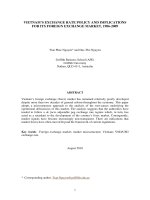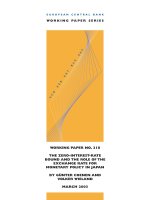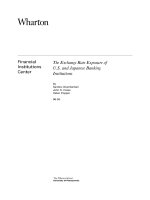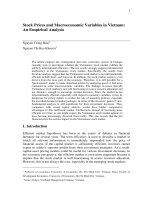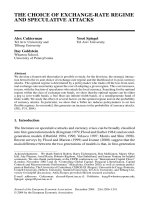Exchange rate and stock prices
Bạn đang xem bản rút gọn của tài liệu. Xem và tải ngay bản đầy đủ của tài liệu tại đây (1.1 MB, 6 trang )
Macro Report
Exchange rate shocks and stock prices
in Vietnam
Macro Report
July 31, 2018
Mirae Asset Securities Vietnam Co., Ltd.
[Macro]
Minh Le
+84 3910 2222 (Ext: 177)
Tran Nguyen
+84 3910 2222 (Ext: 139)
Background
Macroeconomic shocks refer to sudden changes in economic conditions
(GDP growth, exchange rates, inflation, interest rates, etc.). Such changes
are often key determinants of stock prices, as the stock market is not just an
investing channel but also a reflection of the state of an economy. Stock prices
reflect expectations on companies’ performance and the future economic
environment. Recently, we have seen an inverse relationship between
exchange rates and stock market performance in developing countries (China,
Malaysia, Thailand, the Philippines, etc.). The main objective of this report is
to measure the contribution made by exchange rate shocks to stock price
variations in Vietnam.
Theoretically, the link between exchange rates and stock prices is explained
by the “flow-oriented” model proposed by Dornbusch and Fisher (1980).
Under this model, exchange rate fluctuations affect a firm’s value through
changes in international competitiveness and the value of foreign currencydenominated assets and liabilities, factors that ultimately affect profits and
therefore equity value. Depreciation of a domestic currency could lead to an
increase in firm competitiveness by enhancing demand for exports, thereby
raising profits and stock price.
Figure 1. Exchange rate
23,500
23,400
23,300
23,200
23,100
23,000
Official rate (SBV)
Unofficial rate
Mid Com. banks
22,900
22,800
22,700
22,600
22,500
22,400
22,300
Source: Bloomberg, updated 07/26/2018
Since May 2018, concerns about the devaluation of the Vietnamese dong
(VND) have mounted among both overseas and local investors. The official
and unofficial exchange rates have moved significantly (see Figure 1). The
USD/VND rate of commercial banks has risen from 22,800 in May to 23,200
in July, driven in part by an official devaluation (about 1%) of the local currency
by the State Bank of Vietnam (SBV) on July 23rd. Investors are waiting for
answers as to whether, to what extent, and for how long the exchange rate
shock will affect the VN-Index.
Analysts who prepared this report are registered as research analysts in Korea but not in any other jurisdiction, including the U.S.
PLEASE SEE ANALYST CERTIFICATIONS AND IMPORTANT DISCLOSURES & DISCLAIMERS IN APPENDIX 1 AT THE END OF REPORT.
Macro Report
July 31, 2018
Methods
To answer these questions, we employ two models: the Johansen cointegration test
and the vector error correction model (VECM). The Johansen cointegration test is a
test of the null hypothesis of no cointegration (a long-run stochastic trend or longterm balance) against the alternative of cointegration. The VECM is used to find the
sign and magnitude of a possible shock-related impact on the VN-Index. We use
monthly data from Bloomberg from May 2009 until now. In addition to the potential
exchange rate impact, other macroeconomic indicators such as inflation (CPI),
economic activities (industrial production index), and short- and long-term interest
rates (interbank 3-month yield, and government 1-year bond yield) can deliver
shocks to the VN-Index, and we therefore incorporate these variables into our model.
We skip introduction of the models for brevity, but they are available upon request.
Findings
Positive linkage of exchange rate
The results of our Johansen cointegration test, shown in Table 1, suggest some
interesting implications for the long-term balance of the VN-Index and the key macro
indicators. Our primary interest is the potential impact of exchange rates. According
to our results, the exchange rate obtains a positive and statistically significant
parameter at the level of 5%. In other words, exchange rates and stock prices are
cointegrated, with the recent devaluation having a positive impact on the VN-Index.
Regarding other macro indicators, industrial production and long-term interest rates
are also positively cointegrated with the VN-Index, whereas inflation and short-term
interest rates are negatively correlated with the performance of the index.
Table 1: Brief results of our Johansen cointegration test
Coefficients
Significance
Exchange
rate
Inflation
rate
Industrial
production
Short-term
interest rate
Long-term
interest rate
+0.5
(**)
-230.6
(*)
+14.3
(**)
-28.1
(**)
+2.4
(**)
Note: (*), (**) denote statistical significance level at 1% and 5%, respectively.
VN-Index’s response to exchange rate shock within three months
We estimate the length of time that an exchange rate shock affects the VN-Index
using an impulse response function (with a 95% bootstrap confidence interval). We
find that the VN-Index would take about three months to revert to equilibrium. The
VN-Index response to its own shock and to an exchange rate shock is positive,
whereas the response is negative for unexpected changes in CPI and short-run
interest rates.
Short-term balance of the VN-Index
The short-term imbalance of the VN-Index is corrected for the long-term equilibrium
according to an error correction term that is captured by the Johansen cointegration
test. By this mechanism, we estimate the impact of all five macro indicators on VNIndex because they are significantly time-varying and long-term correlated with the
index. The error correction term is significant in the VN-Index equation, verifying that
approximately 6.58% of the discrepancy between the actual value and the long-term
value is adjusted each month (the term is negative and significant at the 5% level).
Additionally, regarding the short-run balance, movements of the VN-Index (at time t)
are explained by past changes in the index itself and in macroeconomic indicators
(at time t-1). The contemporaneous effects of exchange rates, industrial production
growth, and long-term interest rates on the VN-Index are positive, while the effects
of inflation and short-term interest rates are negative.
Mirae Asset Daewoo Research
2
Macro Report
July 31, 2018
VN-Index prediction
Based on the estimated VECM models (we do not show the six regressions of shortterm balance, but they are available upon request), the fitted values of the VN-Index
are calculated for a back-test of the period from May 2009 to June 2018 and
compared with the actual value of the VN-Index. The prediction for the VN-Index is
presented in Figure 2 and Table 2. The results show that the VN-Index is expected
to move up to around 1,000 between now and June 2019.
VN-Index (forecasted)
Lower
1300
1250
1200
1150
1100
1050
1000
950
900
850
800
750
700
650
600
550
500
450
400
350
300
May-19
Jul-18
Dec-18
Feb-18
Apr-17
Sep-17
Nov-16
Jan-16
Jun-16
Aug-15
Mar-15
Oct-14
Dec-13
VN-Index (actual)
May-14
Jul-13
Feb-13
Apr-12
Sep-12
Nov-11
Jan-11
Jun-11
Aug-10
Mar-10
Oct-09
May-09
Figure 2. VN-Index: Back test and prediction
Upper
Source: Mirae Asset Daewoo Research
Table 2: VN-Index scenario
3Q2018
4Q2018
1Q2019
2Q2019
VN-Index
987
992
1047
1033
Volatility
12%
17%
20%
23%
Source: Mirae Asset Daewoo Research
Decomposing the variation of the VN-Index according to each factor
We employ variance decomposition to separate the percentage of the variance in
the VN-Index that can be attributed to its own shock (in prior months), exchange rate
shocks, and other variables in the system. The results, shown in Figure 3, suggest
that the current VN-Index is mainly explained by its previous changes. Among macro
indicators, the rate of inflation is the strongest explanatory variable. In the first month,
100% of the variability in the VN-Index is explained by its own shocks, whereas after
the 6th month, about 91% of the variability is explained by its own changes and nearly
7% by the inflation rate. After the 12th month, these figures are 87% and 9%,
respectively. Exchange rate fluctuations can also explain the variation in the VNIndex, but the economic magnitude is small (about 2% after the 10th month). This
finding indicates that an exchange rate shock does not have much influence on index
returns.
Mirae Asset Daewoo Research
3
Macro Report
July 31, 2018
Figure 3. Decomposition VN-Index variation by each factor
100%
1%
1%
98%
1%
1%
2%
1%
1%
1%
1%
1%
1%
1%
1%
1%
1%
1%
1%
1%
2%
2%
2%
8%
9%
9%
9%
89%
88%
88%
88%
87%
8
9
10
11
12
4%
96%
5%
7%
94%
7%
8%
92%
90%
100%
99%
97%
88%
94%
92%
86%
91%
90%
84%
82%
80%
1
2
3
4
VN-Index
Industrial production
5
6
7
Inflation rate
ST interest rate
Exchange rate
LT interest rate
Source: Mirae Asset Daewoo Research
Conclusion
We have tried to determine the relationship between the stock market and exchange
rates, applying both the Johansen cointegration vector and vector error correction
model to test for the long- and short-term linkages. We find that a devaluation of the
VND is positively correlated with VN-Index returns, and the index response to an
exchange rate shock lasts for three months on average. However, the impact of the
shock is minor. On the other hand, the variance of the VN-Index can be largely
explained by its own past variations, which suggests that technical analysis is a
trustworthy tool for buy and sell timing.
References
Dornbusch, R., Fischer, S., 1980. Exchange rates and the current account. American Economic Review
70 (5), 960–971.
Mirae Asset Daewoo Research
4
July 31, 2018
Macro Report
APPENDIX 1
Important Disclosures & Disclaimers
Analyst Certification
The research analysts who prepared this report (the “Analysts”) are subject to Korean securities regulations. They are neither registered as research analysts in any
other jurisdiction nor subject to the laws and regulations thereof. Opinions expressed in this publication about the subject securities and companies accurately reflect
the personal views of the Analysts primarily responsible for this report. Mirae Asset Securities Vietnam Co., Ltd. (“Mirae Asset”) policy prohibits its Analysts and members
of their households from owning securities of any company in the Analyst’s area of coverage, and the Analysts do not serve as an officer, director or advisory board
member of the subject companies. Except as otherwise specified herein, the Analysts have not received any compensation or any other benefits from the subject
companies in the past 12 months and have not been promised the same in connection with this report. No part of the compensation of the Analysts was, is, or will be
directly or indirectly related to the specific recommendations or views contained in this report but, like all employees of Mirae Asset, the Analysts receive compensation
that is determined by overall firm profitability, which includes revenues from, among other business units, the institutional equities, investment banking, proprietary
trading and private client division. At the time of publication of this report, the Analysts do not know or have reason to know of any actual, material conflict of interest of
the Analyst or Mirae Asset except as otherwise stated herein.
Disclaimers
This report is published by Mirae Asset, a broker-dealer registered in the Socialist Republic of Vietnam and a member of the Vietnamese Exchange.
Information and opinions contained herein have been compiled in good faith and from sources believed to be reliable, but such information has not been
independently verified and Mirae Asset makes no guarantee, representation or warranty, express or implied, as to the fairness, accuracy, completeness or
correctness of the information and opinions contained herein or of any translation into English from the Vietnamese language. In case of an English translation
of a report prepared in the Vietnamese language, the original Vietnamese language report may have been made available to investors in advance of this
report.
The intended recipients of this report are sophisticated institutional investors who have substantial knowledge of the local business environment, its common
practices, laws and accounting principles and no person whose receipt or use of this report would violate any laws and regulations or subject Mirae Asset
and its affiliates to registration or licensing requirements in any jurisdiction shall receive or make any use hereof.
This report is for general information purposes only and it is not and shall not be construed as an offer or a solicitation of an offer to effect transactions in any
securities or other financial instruments. The report does not constitute investment advice to any person and such person shall not be treated as a client of
Mirae Asset by virtue of receiving this report. This report does not take into account the particular investment objectives, financial situations, or needs of
individual clients. The report is not to be relied upon in substitution for the exercise of independent judgment. Information and opinions contained herein are
as of the date hereof and are subject to change without notice. The price and value of the investments referred to in this report and the income from them
may depreciate or appreciate, and investors may incur losses on investments. Past performance is not a guide to future performance. Future returns are not
guaranteed, and a loss of original capital may occur. Mirae Asset, its affiliates and their directors, officers, employees and agents do not accept any liability
for any loss arising out of the use hereof.
Mirae Asset may have issued other reports that are inconsistent with, and reach different conclusions from, the opinions presented in this report. The reports
may reflect different assumptions, views and analytical methods of the analysts who prepared them. Mirae Asset may make investment decisions that are
inconsistent with the opinions and views expressed in this research report. Mirae Asset, its affiliates and their directors, officers, employees and agents may
have long or short positions in any of the subject securities at any time and may make a purchase or sale, or offer to make a purchase or sale, of any such
securities or other financial instruments from time to time in the open market or otherwise, in each case either as principals or agents. Mirae Asset and its
affiliates may have had, or may be expecting to enter into, business relationships with the subject companies to provide investment banking, market-making
or other financial services as are permitted under applicable laws and regulations.
No part of this document may be copied or reproduced in any manner or form or redistributed or published, in whole or in part, without the prior written consent
of Mirae Asset.
Distribution
United Kingdom: This report is being distributed by Mirae Asset Securities (UK) Ltd. in the United Kingdom only to (i) investment professionals falling within
Article 19(5) of the Financial Services and Markets Act 2000 (Financial Promotion) Order 2005 (the “Order”), and (ii) high net worth companies and other
persons to whom it may lawfully be communicated, falling within Article 49(2)(A) to (E) of the Order (all such persons together being referred to as “Relevant
Persons”). This report is directed only at Relevant Persons. Any person who is not a Relevant Person should not act or rely on this report or any of its contents.
United States: This report is distributed in the U.S. by Mirae Asset Securities (USA) Inc., a member of FINRA/SIPC, and is only intended for major institutional
investors as defined in Rule 15a-6(b)(4) under the U.S. Securities Exchange Act of 1934. All U.S. persons that receive this document by their acceptance
thereof represent and warrant that they are a major institutional investor and have not received this report under any express or implied understanding that
they will direct commission income to Mirae Asset Daewoo or its affiliates. Any U.S. recipient of this document wishing to effect a transaction in any securities
discussed herein should contact and place orders with Mirae Asset Securities (USA) Inc., which accepts responsibility for the contents of this report in the
U.S. The securities described in this report may not have been registered under the U.S. Securities Act of 1933, as amended, and, in such case, may not be
offered or sold in the U.S. or to U.S. persons absent registration or an applicable exemption from the registration requirements.
Hong Kong: This document has been approved for distribution in Hong Kong by Mirae Asset Securities (HK) Ltd., which is regulated by the Hong Kong
Securities and Futures Commission. The contents of this report have not been reviewed by any regulatory authority in Hong Kong. This report is for distribution
only to professional investors within the meaning of Part I of Schedule 1 to the Securities and Futures Ordinance of Hong Kong (Cap. 571, Laws of Hong
Kong) and any rules made thereunder and may not be redistributed in whole or in part in Hong Kong to any person.
All Other Jurisdictions: Customers in all other countries who wish to effect a transaction in any securities referenced in this report should contact Mirae Asset
Daewoo or its affiliates only if distribution to or use by such customer of this report would not violate applicable laws and regulations and not subject Mirae
Asset Daewoo and its affiliates to any registration or licensing requirement within such jurisdiction.
Mirae Asset Daewoo Research
5
Macro Report
July 31, 2018
Mirae Asset Daewoo International Network
Mirae Asset Daewoo Co., Ltd. (Seoul)
Global Equity Sales Team
Mirae Asset Center 1 Building
26 Eulji-ro 5-gil, Jung-gu, Seoul 04539
Korea
Mirae Asset Securities (UK) Ltd.
41st Floor, Tower 42
25 Old Broad Street,
London EC2N 1HQ
United Kingdom
Tel: 82-2-3774-2124
Mirae Asset Securities (HK) Ltd.
Suites 1109-1114, 11th Floor
Two International Finance Centre
8 Finance Street, Central
Hong Kong
China
Tel: 852-2845-6332
Mirae Asset Securities (USA) Inc.
810 Seventh Avenue, 37th Floor
New York, NY 10019
USA
Mirae Asset Wealth Management (USA) Inc.
555 S. Flower Street, Suite 4410,
Los Angeles, California 90071
USA
Tel: 1-212-407-1000
Tel: 1-213-262-3807
Mirae Asset Wealth Management (Brazil) CCTVM
Rua Funchal, 418, 18th Floor, E-Tower Building Vila
Olimpia
Sao Paulo - SP
04551-060
Brasil
Tel: 55-11-2789-2100
PT. Mirae Asset Sekuritas Indonesia
Equity Tower Building Lt. 50
Sudirman Central Business District
Jl. Jend. Sudirman, Kav. 52-53 Jakarta Selatan
12190
Indonesia
Tel: 62-21-515-3281
Mirae Asset Securities (Singapore) Pte. Ltd.
6 Battery Road, #11-01
Singapore 049909
Republic of Singapore
Mirae Asset Securities (Vietnam) LLC
7F, Saigon Royal Building
91 Pasteur St.
District 1, Ben Nghe Ward, Ho Chi Minh City
Vietnam
Tel: 65-6671-9845
Tel: 84-8-3911-0633 (ext.110)
Mirae Asset Securities Mongolia UTsK LLC
Mirae Asset Investment Advisory (Beijing) Co., Ltd
Beijing Representative Office
#406, Blue Sky Tower, Peace Avenue 17
1 Khoroo, Sukhbaatar District
Ulaanbaatar 14240
Mongolia
2401B, 24th Floor, East Tower, Twin Towers
B12 Jianguomenwai Avenue, Chaoyang District
Beijing 100022
China
2401A, 24th Floor, East Tower, Twin Towers
B12 Jianguomenwai Avenue, Chaoyang District
Beijing 100022
China
Tel: 976-7011-0806
Tel: 86-10-6567-9699
Tel: 86-10-6567-9699 (ext. 3300)
Shanghai Representative Office
Ho Chi Minh Representative Office
38T31, 38F, Shanghai World Financial Center
100 Century Avenue, Pudong New Area Shanghai
200120
China
7F, Saigon Royal Building
91 Pasteur St.
District 1, Ben Nghe Ward, Ho Chi Minh City
Vietnam
Tel: 86-21-5013-6392
Tel: 84-8-3910-7715
Mirae Asset Daewoo Research
Tel: 44-20-7982-8000
6
